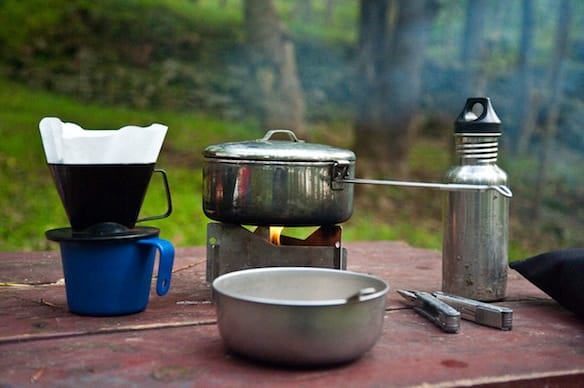
Image credit: Urban Velo.
Time to get cookin’: Your Camp Stove Buying Guide
By Valerie Farabee
The snows are melting, the rains are subsiding, and a general aura of new and fresh permeates the fragrant, rain-soaked, fresh-cut grass aroma of early spring. Obviously it’s time to go camping. Whether simply car camping or a week long backpacking trip, you will eventually need to cook some food. You can rub two sticks together – a time tested method for starting a fire and roasting a hunk of energy on top of it – or you can go a slightly simpler route and bring along a camp stove!
A camp stove is a stove specially designed to be portable and lightweight for people who are car camping, canoeing, backpacking or otherwise carrying their supplies with them. They are similar in function and ease of use to kitchen cooktops, and can be used in a wide variety of settings. Read on to find out the important things to consider when buying a camp stove.
Fuel Your Stove with Facts
The first thing to consider when choosing a camping stove is the type of fuel you’ll be using. Be sure to pick a stove that is fueled by a power source that is available where you intend to use the stove – never use a fuel that the stove is not designed for; you might explode. Although there are a number of different fuels to choose from, the most popular fuel choices for camping stoves are white gas, propane, and butane.
White Gas is a generic name for camp stove and lantern fuel, usually but not always this refers to naphtha. It has a high heat output and is readily available in the USA. This is the best choice for all seasons camping. Beware that it can sometimes produce sooty smoke, and spilled fuel is highly flammable.
Propane remains a popular choice for portable stoves. It is better in the cold than its bastard cousin, butane, and its canisters are refillable. The canisters can add extra weight to your pack, and propane is not as easily available as white gas, but it remains a popular fuel for larger setups that don’t depend on size or weight.
Butane does not do very well in the cold, which is important if you are planning on any camping at cooler temperatures. It is more widely used in Europe than in the USA, so if you are planning any international camping, check on what fuel is available at your destination!
Size Matters
Once you’ve decided on the type of fuel you’ll be using, it’s time to drill down the size.
Double-burner stoves like the classic Coleman are great for car camping and easy to use. These are relatively inexpensive, and can be had for between $50 – $110. Like your stove at home, these stoves have a couple of burners that allow you to cook more than one thing at a time. Some models even come with a grill attachment, great if you want to grill some meat while making a sauce at the same time! These are great for cooking meals for larger groups of people. These stoves are not great if you are attempting to summit Mt. Everest – too big, heavy and clunky to be of good use for an elite climber. Leave the two burner at basecamp and take a more compact model with you to the summit.
Compact stoves like the MSR Whisperlite, or even the super compact Jetboil Flash are much better choices for multi-day backpacking or mountain climbing. They are light, sturdy, versatile, and easy to use. The Whisperlite is well known as the best all around stove of it’s kind, can be had for between $80 – $140, depending on configuration you choose. The jetboil, available for between $80 – $120, is incredibly light, compact, and is great for cooking freeze-dried meals in a flash.
Which Price is Right?
Materials and workmanship drive the price of the stove, so size is not necessarily an indicator of how much a stove might cost. A top quality, featherweight backpacking stove will run at least $80, while a two-burner, cast iron, camp-kitchen size stove + grill will cost easily around $200. A propane camp stove can be found for around $100, while the time-honored Coleman 2-burner can be found at it’s cheapest around $50. Don’t have that kind of scratch? You can find a pocket stove, like the Esbit, with a supply of fuel pellets for $10 and under.
Camp Cooking is Fun!
Buying a camping stove is easy! First, figure out where you are going to use it so you know what kind of fuel will be available. Next, decide how you are going to use it – will you be using it on a multi-day backpacking trip, or at a family tailgating event, or maybe a combination of both? When you have those factors figured out, you will have a better idea of your needs as far as the size and versatility of the camping stove you’d like to buy. Make sure the stove you’ve decided on is compatible with your fuel needs, and you are all set!
Happy cooking, folks!



